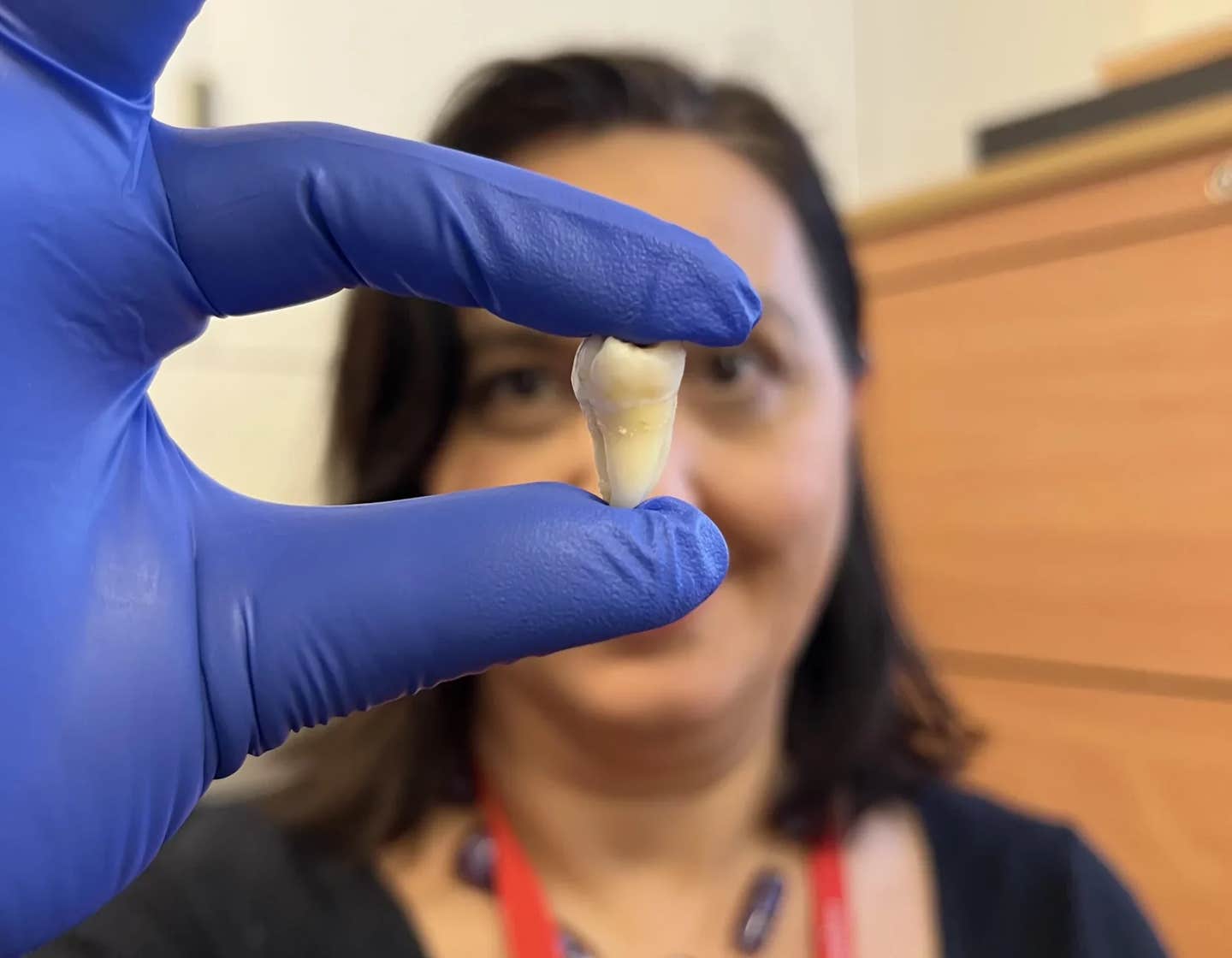Scientists grow real teeth in the lab – replacing fillings and implants
Scientists have discovered how to grow real, living teeth in the lab, offering a future alternative to fillings and implants.

Dr Ana Angelova Volponi holding a tooth. (CREDIT: King’s College London)
Tooth loss affects millions around the world, caused by decay, gum disease, injuries, and some diseases. Missing teeth do more than make it hard to chew or talk. They also impact appearance and self-esteem. Although dentures and implants have helped millions, they cannot fully replace the natural feel and function of real teeth. Scientists have long searched for a way to regenerate teeth — not with artificial materials, but with living, growing cells.
Today, the dream of growing real, living teeth in a lab is closer than ever. Researchers from King’s College London and Imperial College London have made key discoveries about the materials and conditions needed to create teeth from scratch. Their findings build on years of progress in regenerative dentistry, a field that aims to engineer whole organs by mimicking natural development.
Building Teeth from Cells: A New Approach
For teeth to grow naturally, two types of cells must interact: epithelial cells and mesenchymal cells. Back in 1987, researchers Mina and Kollar showed that epithelial cells from the first branchial arch could trigger non-tooth-forming mesenchymal cells to create dental tissues.
Later experiments proved that even when separated, dental epithelial and mesenchymal cells could be rejoined in the lab to create small tooth-like structures, known as organoids.
Organoids are three-dimensional clusters of cells that imitate the structure and behavior of real organs. In the case of teeth, organoids mimic the stages of real tooth development, from bud to cap to bell stage, eventually leading to enamel, dentin, and supporting structures.
Scientists have even proven that adult stem cells can join the process. For instance, Ohazama and his team used bone marrow mesenchymal cells with early dental epithelium to form teeth in vitro. Similarly, previous research showed that human gum cells can respond to signals from mouse dental mesenchyme to start forming teeth.
However, success depends heavily on the environment surrounding the cells. They must live inside materials that allow them to interact properly — and that’s where hydrogels come in.
Related Stories
Hydrogels: Creating the Perfect Environment for Tooth Growth
Biomaterials used in tissue engineering must not just hold cells but also help them talk to each other. Materials like polyglycolide acid (PGA), polylactic acid (PLA), poly(lactic-co-glycolic acid) (PLGA), collagen sponges, and Matrigel have been tested for this purpose. Yet many of these materials lack the ability to fine-tune physical and mechanical properties, limiting how much control scientists have over the tooth-making process.
In a breakthrough study, researchers engineered hydrogels cross-linked with bioorthogonal chemistry — a special method that allows two chemicals to bond under natural conditions without interfering with cellular processes. They used gelatin, a safer and easier-to-work-with form of collagen, modified with two chemical groups: tetrazine (Tz) and norbornene (Nb).
By adjusting the concentration of gelatin and the ratio of these chemical groups, they could finely control the stiffness and other properties of the hydrogel. This tunability is critical because cell behavior, especially in three-dimensional cultures, is highly sensitive to the mechanical environment.
The team created hydrogels with elastic moduli between 2 and 7 kilopascals (kPa) and storage moduli between 500 and 1500 pascals. After injecting mouse embryonic tooth germs into the hydrogels, they found that softer hydrogels allowed for better growth and structure formation compared to stiffer ones.
Hydrogels with an 8% gelatin concentration and a 0.5 Tz:Nb ratio provided the best environment. Tooth organoids formed consistently in this softer matrix, showing well-developed enamel-like and mesenchymal layers. Meanwhile, stiffer hydrogels slowed down tooth growth and led to malformed or incomplete structures.
Mimicking Nature's Timing: Controlled Signal Release
Tooth development is a tightly regulated process. Cells must not only interact but do so at the right pace. In earlier attempts to engineer teeth, cells received all developmental signals at once, which overwhelmed the natural process.
This time, researchers developed hydrogels that slowly released molecular signals over time, closely copying how cells communicate during real tooth formation. According to Xuechen Zhang from King’s College London, “We developed this material in collaboration with Imperial College to replicate the environment around the cells in the body, known as the matrix. This meant that when we introduced the cultured cells, they were able to send signals to each other to start the tooth formation process."
Such advances ensure that cells self-organize and mature at the correct stages, leading to more natural and functional tooth organoids.
From Lab Bench to Dental Chair
While scientists have created tooth organoids in the lab, the next challenge is getting them into patients’ mouths. Two main strategies are being explored: transplanting young tooth cells into the jaw where the tooth is missing or growing a whole tooth in the lab first and then implanting it.
Either method requires starting the very early stages of tooth development in the lab under precisely controlled conditions. This process will take time to perfect, but early results are promising.
According to Dr. Ana Angelova Volponi from King’s College London, “As the field progresses, the integration of such innovative techniques holds the potential to revolutionise dental care, offering sustainable and effective solutions for tooth repair and regeneration."
If successful, this approach would mean no more dentures, fillings, or implants. Instead, your own cells could grow a real, living tooth — a permanent, natural replacement.
A Future Without Fillings?
Unlike fillings and implants, lab-grown teeth would integrate naturally with your jawbone. They could grow, adapt, and even heal themselves, just like natural teeth. No more worries about fillings cracking, implants loosening, or repeated surgeries.
Animals like sharks and elephants regenerate teeth naturally. Now, through careful science and engineering, humans could someday join them. Thanks to advances in hydrogel engineering, controlled signaling, and stem cell biology, regenerative dentistry has moved from science fiction closer to reality.
Scientists at King’s College London and their collaborators have demonstrated that by mimicking the natural tooth development environment, it is possible to guide cells into creating full teeth in the lab. It is a major leap forward for a field that could one day allow millions of people to repair or regrow their teeth naturally.
Research findings are available online in the journal ACS Macro Letters.
Note: The article above provided above by The Brighter Side of News.
Like these kind of feel good stories? Get The Brighter Side of News' newsletter.
Joseph Shavit
Head Science News Writer | Communicating Innovation & Discovery
Based in Los Angeles, Joseph Shavit is an accomplished science journalist, head science news writer and co-founder at The Brighter Side of News, where he translates cutting-edge discoveries into compelling stories for a broad audience. With a strong background spanning science, business, product management, media leadership, and entrepreneurship, Joseph brings a unique perspective to science communication. His expertise allows him to uncover the intersection of technological advancements and market potential, shedding light on how groundbreaking research evolves into transformative products and industries.



